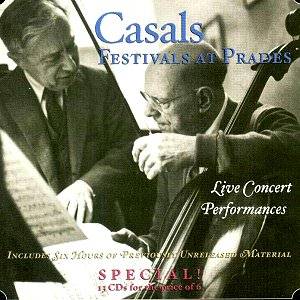





BUY NOW
Crotchet AmazonUK AmazonUS around £50
AVAILABILITY
www.musicandarts.com
Wolfgang Amadeus MOZART (1756-1791)
PiaNo.Quartet No.2 in E flat, K.493 (Horszowski, Y. Menuhin, Wallfisch, Casals)
PiaNo.Quartet No.2 in E flat, K.493 (Kapell, Grumiaux, Thomas, Tortelier)
Oboe Quartet in F, K.370 (Tabuteau, Pernel, Tuttle, Tortelier)
Clarinet Quintet in A, K.581 (Gonzales, Vegh Quartet)
"Zeffiretti lusinghieri" from Idomeneo (de los Angeles, Collegium Musicum, conducted by. Casals)
Robert SCHUMANN (1810-1856)
Trio No.1 in D Minor, Op. 63 (Szigeti, Horszowski, von Tobel)
Trio No.2 in F, Op. 80 (Menuhin, Horszowski, Casals)
Trio No.3 in G Minor, Op. 110 (Vegh, Serkin, Casals)
Adagio and Allegro in A flat for piaNo.and horn (Curzon, Casals)
String Quartet in A Minor, Op. 41, No.1 (Vegh Quartet)
PiaNo.Quintet in E flat, Op. 44 (Serkin, Vegh Quartet)
Ludwig van BEETHOVEN (1770-1827)
Piano Trio in C Minor, Op. 1, No.3 (Y. and H. Menuhin, Casals)
Piano Trio in D, Op. 70, No.1 "Ghost" (Goldberg, Serkin, Casals)
Piano Trio in E flat, Op. 70, No.2 (Goldberg, Serkin, Casals)
Piano Trio in D, Op. 121a "Kakadu" Variations (Goldberg, Serkin, Casals)
Sonata in F [No.1] for Cello and Piano, Op. 5, No.1 (Casals, Serkin)
Sonata in G Minor [No.2] for Cello and Piano, Op. 5, No.2 (Casals, Istomin)
Sonata in A [No.3] for Cello and Piano, Op. 69 (Casals, Cortot)
Sonata in C [No.4] for Cello and Piano, Op. 102, No.1 (Casals, Serkin)
Sonata in D [No.5] for Cello and Piano, Op. 102, No.2 (Casals, Horszowski)
Seven Variations on "Bei Männern" (Casals, Cortot)
Sonata in D [No.1] for Piano and Violin, Op. 12, No.1 (Kapell, Grumiaux)
Sonata in A [No.6] for Piano and Violin, Op. 30, No.1 (Horszowski, Goldberg)
Horn Sonata in F, Op. 17 (Casals, Horszowski)
Johannes BRAHMS (1833-1897)
Trio No.1 in B, Op. 8 (Y. Menuhin, Istomin, Casals)
Trio No.2 in C, Op. 87 (Y. Menuhin, Istomin, Casals)
Trio No.3 in C Minor, Op. 101 (Y. Menuhin, Istomin, Casals)
Clarinet Trio in A Minor, Op. 114 (Oppenheim, Istomin, Casals)
Johann Sebastian BACH (1685-1750)
Cello Suite No.3 in C, BWV 1009 (Casals)
Sonata in G for Cello and Piano, BWV 1027 (Casals, Horszowski)
The Well-Tempered Clavier, Book Two: Preludes and Fugues in D, F-sharp Minor, G, and B Minor (Horszowski)
Franz Peter SCHUBERT (1797-1828): String Quintet in C, Op. 163 (Krachmalnick, Pernel, Tuttle, Foley, Casals)
Felix MENDELSSOHN (1809-1847): PiaNo.Trio in D Minor, Op. 49 (Engel, Vegh, Casals)
William Kapell, Alfred Cortot, Karl Engel, Clifford Curzon, piano
Yehudi Menuhin, Sandor Végh, Szymon Goldberg, Arthur Grumiaux,
Orrea Pernel, Joseph Szigeti, Jacob Krachmalnick, violin
Ernst Wallfisch, Milton Thomas, Karen Tuttle, viola
Pablo Casals, Paul Tortelier, Rudolph von Tobel, Madeline Foley, cello
David Oppenheim, Jose Gonzales, clarinet
Marcel Tabuteau, oboe
Victoria de los Angeles, soprano
Collegium Musicum (London)
Végh Quartet Recorded 1953-60